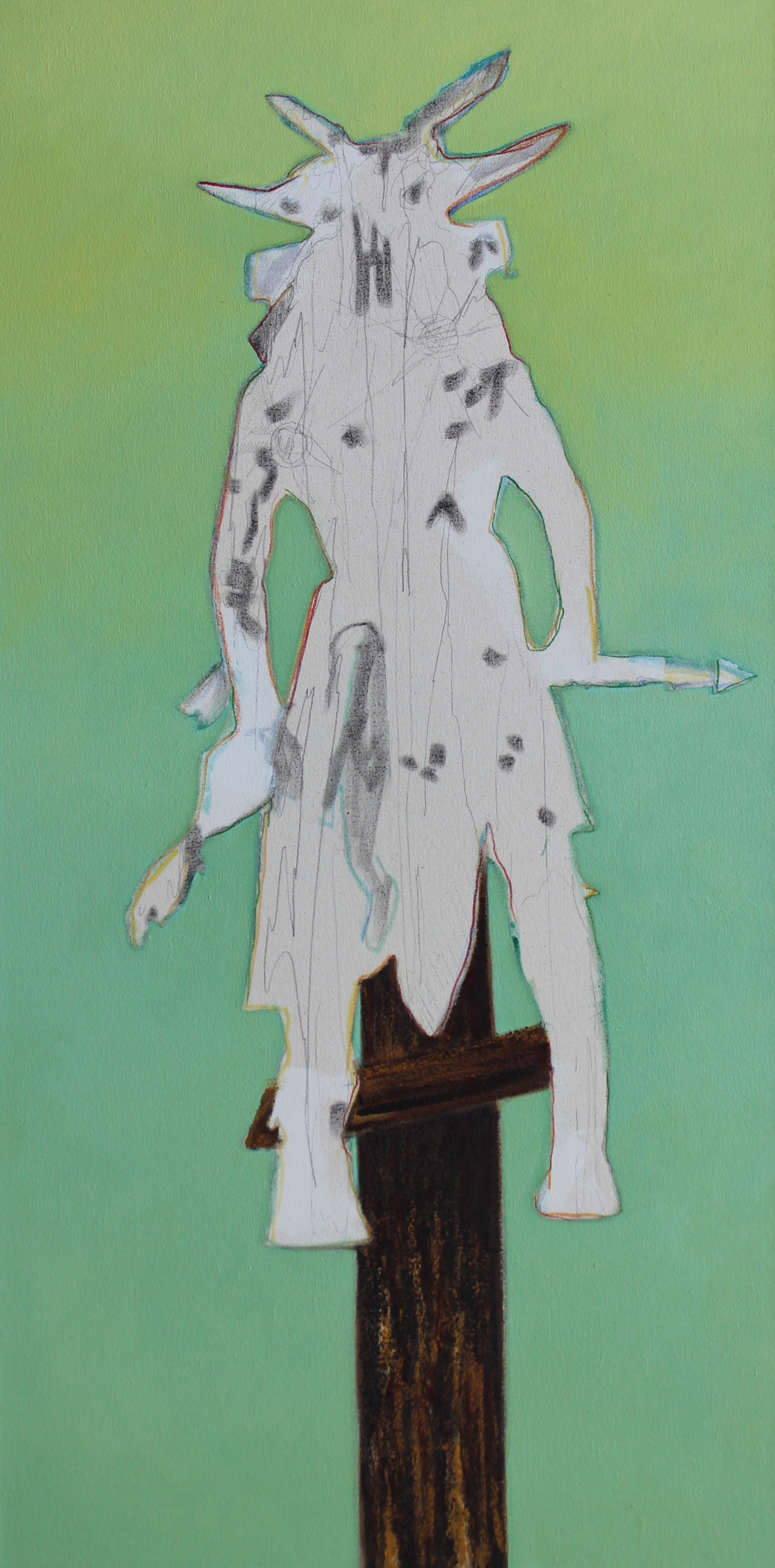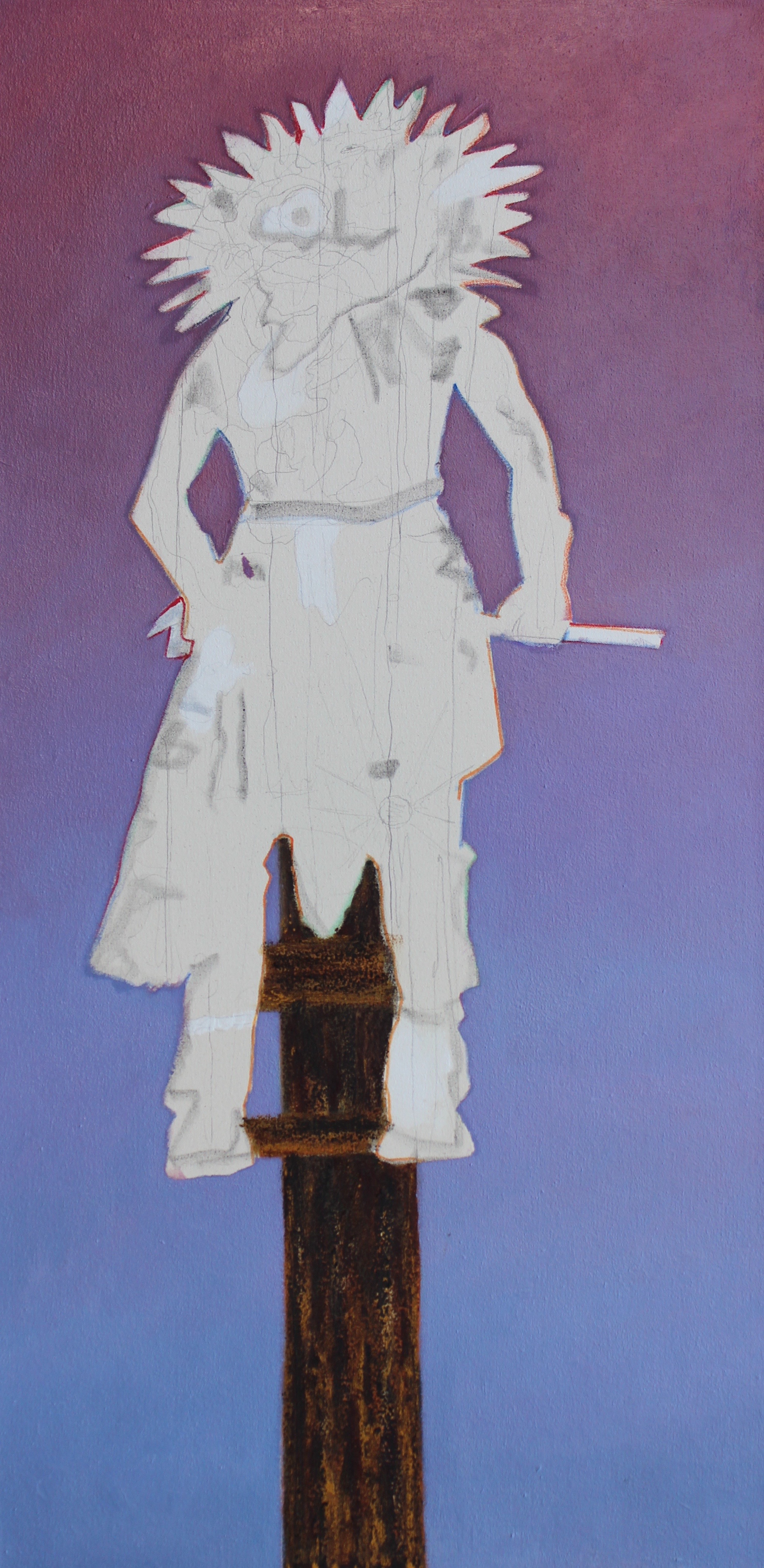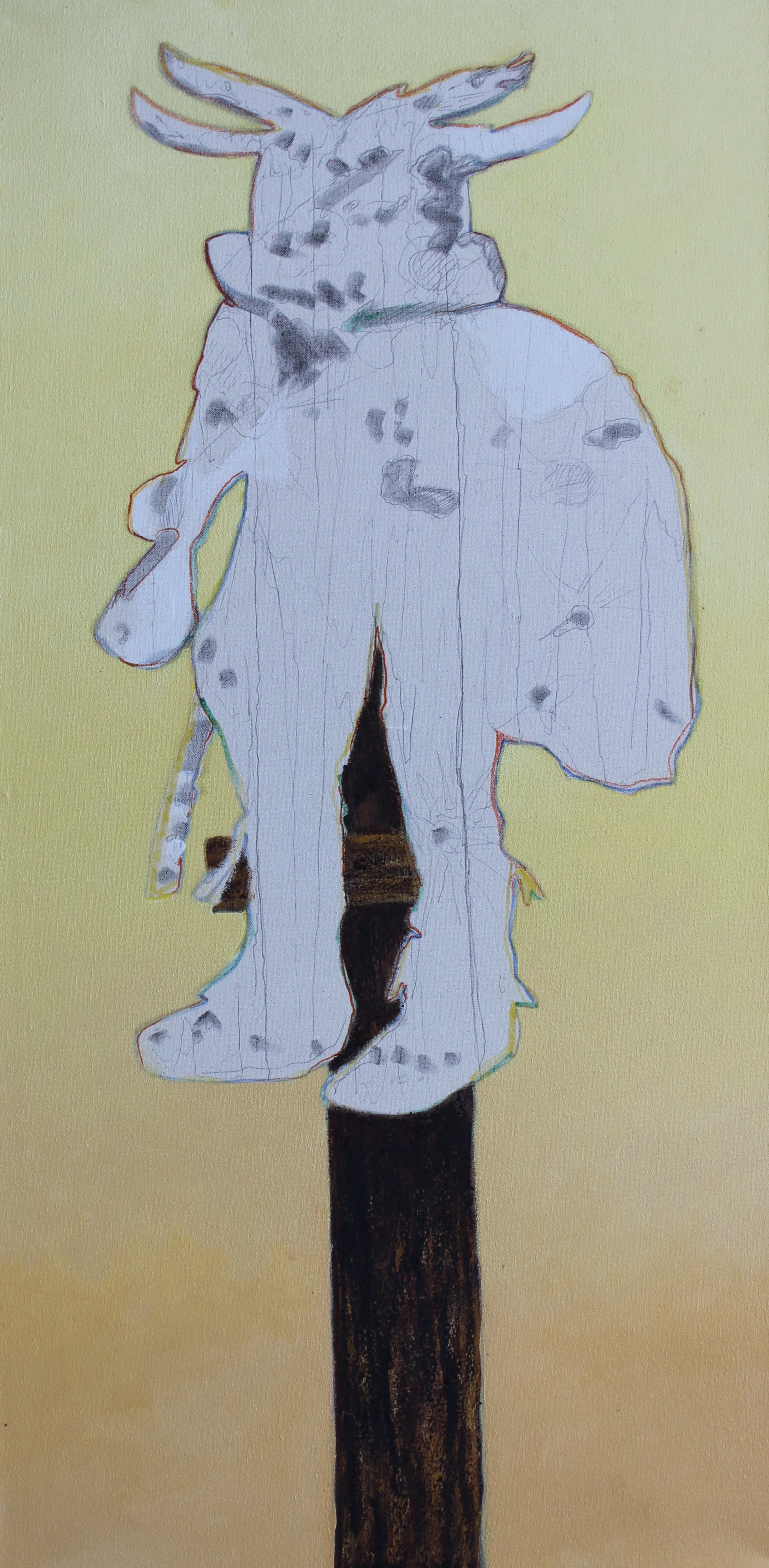Patrick Kikut [Interview]
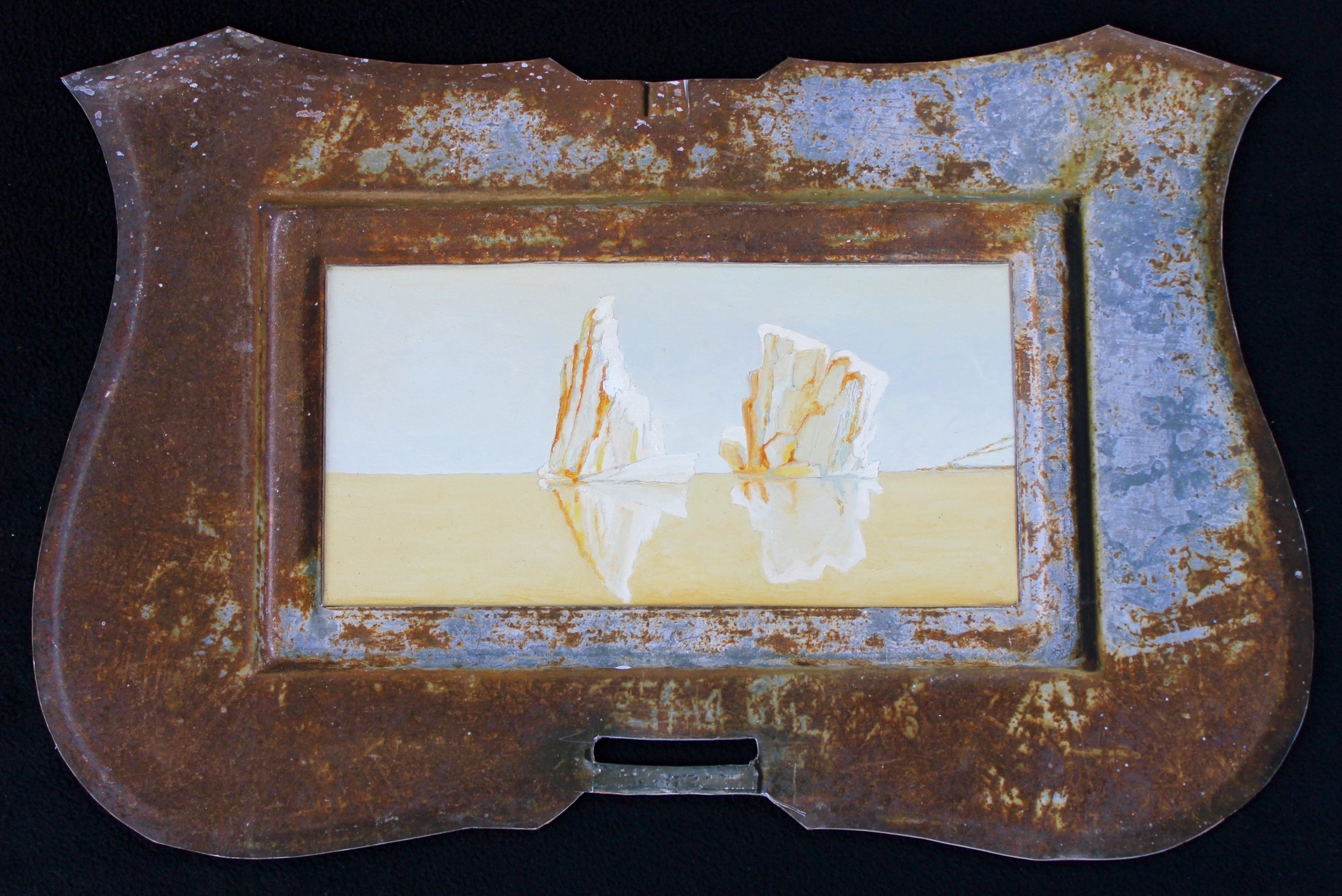

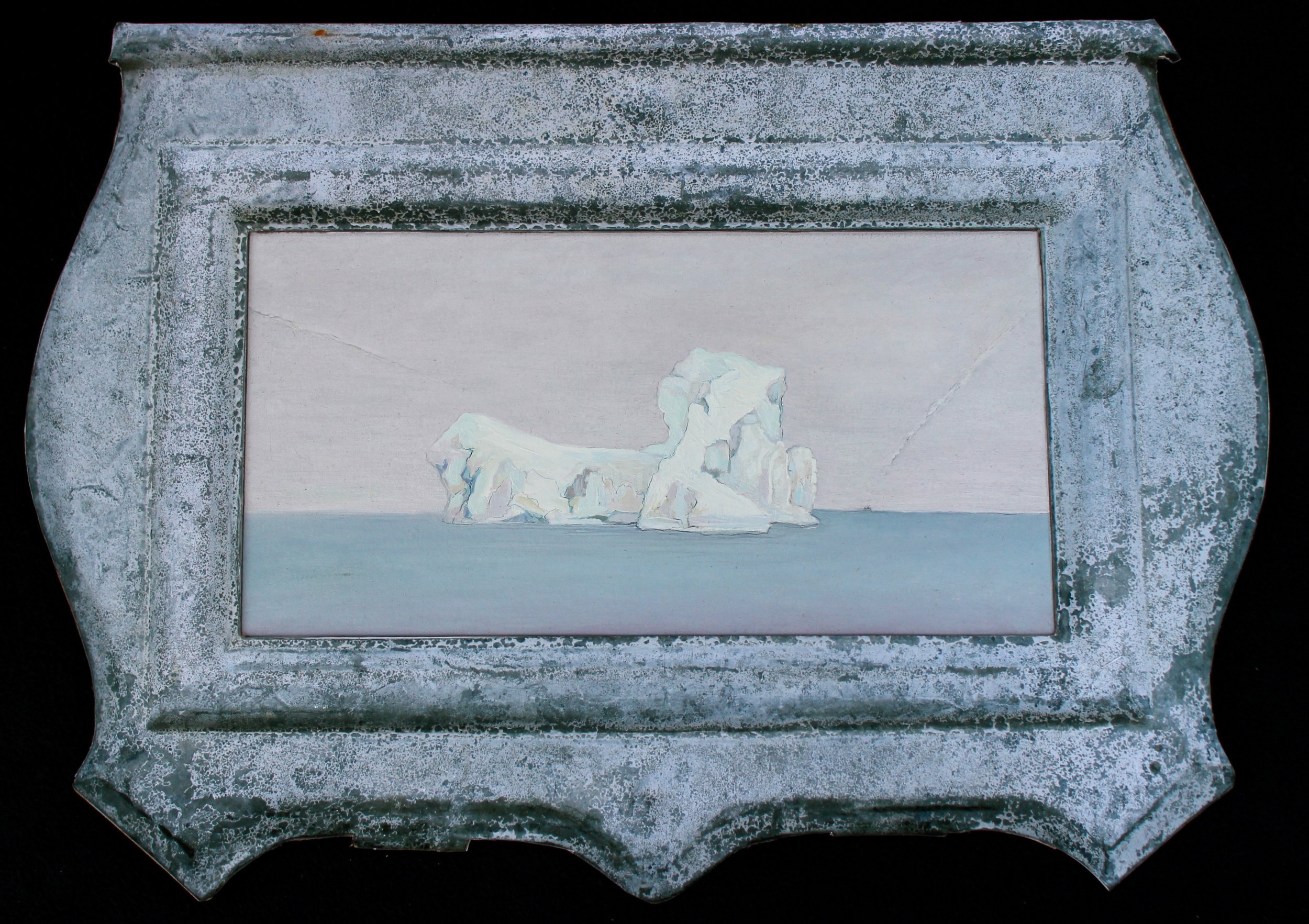
A note from MHM:
Patrick is the type of artist who has truly turned their life into their artistic practice. He drives through the desert religiously for inspiration, spending extended time in nature making and researching. His paintings are ruminations of place with fresh air that dig at contemporary issues. They evoke memories of early 19th century landscape paintings, yet permeate into deeper reflections on our earth’s current environmental state. Kikut's work builds stages upon which the viewer unfolds their own story, sometimes even painting artifacts for viewers to investigate the work as a crime scene. We were really excited to have met Patrick at Coop Gallery in Nashville, TN during Spring 2018, where he was exhibiting his new iceberg series. From there, we arranged an email interview to further discuss his intrepid life and practice. All images were submitted by Patrick.
-Claire Bloomfield, Curator
MH: What is your current project?
PK: My current project is the Sesquicentennial Colorado River Exploration Exhibition (SCREE).
It is the 150th anniversary of John Wesley Powell’s first trip through that route into what he called “The Great Unknown.”
“I am serving as lead artist in a 1000-mile float through the Green and Colorado rivers. ”
I am serving as lead artist in a 1000-mile float through the Green and Colorado rivers. We will put in on May 24th, 2019 in Green River, Wyoming and float for 90 days. I plan to make drawings and paintings of the river, land and culture of the geography we will experience. But, I am open and hoping that I can engage with other media as well. I can’t imagine spending that much time in the muddy waters and slot canyons without trying to approach clay as a medium. On this project, I am a “through tripper” and one of five artists who will join the journey at set boat launch sites. We will be working along side boatmen, swampers, writers, scientists, activists, and scholars.
Since the total eclipse of the sun, which I had a project connected to for 3 years, I have been accessing the Green and Colorado rivers to make drawings and paintings. To prepare for this trip I have been reading about John Wesley Powell and everything I can on Thomas Moran’s time with him. It has been addictive to study history and visit sites where Moran worked and witness the effects of Powell’s recommendations regarding water and land use. It has been a real treat to work with the Gilcrease Museum, Yellowstone National Park, and the University of Wyoming and get into the back flat files of their collection. I have been totally blown away with Moran’s field drawings and use them as inspiration for my own work. They hold an incredible sense of economy and specificity… the line and limited color are all ways impressive. The amount of time I spend on the road and thinking about those drawings is a little crazy, but I really benefit from by making these pilgrimages.
“ I feel a kind of responsibility to try to find some thing out there to report on or express in some way.”
I just got back from a trip to the north rim of the Grand Canyon. My friend, and lead SCREE man, Tom Minckley and I gave a presentation at the Grand Canyon River Guide annual conference. We drove and camped all the way down there and I told the folks at the conference that I am really going into new territory. I am a painter that has a practice of working on field drawings alone in remote locations. This project and river trips are totally collaborative. Also, it looks like I will be trading in the paved highway and truck stops for the original highway- the river and Dutch ovens. I’m really excited and the research is keeping me focused.
Green River-Flaming Gorge
MH: How do you work? Do you work on several projects at once or one painting at a time?
PK: I work on one project at a time and several paintings at once. I tend to really indulge in the research- usually road travel, looking at art, and reading. then stretch a bunch of canvases and get into the studio to paint from my field drawings.
MH: What is your relationship to time? (I notice you utilized color to exemplify time in the iceberg series.)
“ I don’t see the land as “timeless” but rather working on what appears to be a very slow metabolism…. until the big one hits…I was raised in earthquake country.”
PK: That is interesting you bring that up. It is interesting to think of color and a relationship with time. Color does have connotations. My work does often play off of our rich history of romantic landscapes. I seek the sublime and color allows for those feelings to be communicated. I feel that the landscapes I often find myself working in are what people would call “timeless.” I don’t see the land as “timeless” but rather working on what appears to be a very slow metabolism…. until the big one hits…I was raised in earthquake country.
MH: What matters to you more: the journey or the relic of a painting?
PK: I can try to answer that this way- I think they both hold importance. I am fortunate that I can travel, hike and journey out onto the land and visit cities and towns. I feel a kind of responsibility to try to find some thing out there to report on or express in some way. If Moran wouldn’t have been making relics, I wouldn’t get to go to Tulsa every few years. I hope my paintings hold some meaning and mark some beauty and can be useful as a relic. I approach a journey with my job as a painter. So being a painter allows me to journey and they both hold a balance for me.
MH: Are there any billboards that have caught your eye lately?
PK: Yes! I visited a favorite out on I 70 in Green River, Utah. I will send you a photo.
It is getting dilapidated and some layers are peeling away revealing an old sign from what looks like the 1960's advertising Harrah’s Resort and Casino in Reno. The colors are great, and the context is perfect as Green River is an LDS (Latter-Day Saints) town and the old temptations of a Reno Resort and Casino are creeping back into visual play.
MH: Can you talk about the mentors in your life and why they were influential?
PK: I have a few mentors I can talk about. Chuck Forsman, Mary Anne Bonjorni, Terry Allen and James Drake. They all were super generous to me and allowed me access to conversations, bullshit sessions and stories. They all love the road, the west and in their own way work to reflect the stories that are being played out on that stage. They were encouraging and got what it was I was (and probably still am) chasing.
MH: Have you ever dreamed about the desert? I love to hear from artists about the dreams that have affected or influenced their practice.
“I had reoccurring dreams where I would be some kind big Paul Bunyan figure dancing, thrashing with tornadoes and chucking baseballs into thunder storms. ”
PK: I have dreamt about the desert. But my best art dreams were when I committed myself to painting in 1987. I had reoccurring dreams where I would be some kind big Paul Bunyan figure dancing, thrashing with tornadoes and chucking baseballs into thunder storms. The whole dream was staged on a square state like Wyoming or Kansas. The states served as dance floor boxing rings in outer space… it was just me and a tornado, Kansas and the cosmos. My paintings of those dreams were terrible, but they were inspiring to me keep going.
MH: In art I think a lot about “hunters” vs. "farmers" -- that is, those who hunt for work and those who cultivate it. I feel like you are, in a sense, the hunter. Does this relate to you?
PK: That is a good one… and on first glance I would say you are right. Can you tell me other “hunter” artists that you can name… can you name other “farmers?” But, I think you are onto something there and would love to talk more about this idea. I feel like I drag my eyes across landscapes like a hunter or tracker would.
MH: I read something about Capitalism in outer space and how advertisements might landmark in the night sky in the future. What do you think of this in relationship to your billboards series and how you talk about billboards as entities that connect land to sky?
PK: Yikes!!! Noooooooo!!! If you are referring to the kachina billboards, it makes sense to make that land sky connection as that was the roll of kachinas on the mesa. We need to pass laws to protect the view of the sky!
MH: What is your definition of uncanny?
PK: Strange, mysterious, weird, supernatural. I should come up with an example for this question. Let me think on that one.
MH: What is your executive process? I understand that you drive through the desert for inspiration, but do you pull over to paint landscapes, paint from memory, or take photographs?
PK: I usually head out with a particular question or interesting geography in mind. I try to spend as much time as I can on the road and mostly camping out… although in cold weather a hotel room serves me really well as a studio. I have a 1964 Avion Trailer that I call the MRS- short for the Mobile Research Studio. In most occasions I have been using the MRS for cover. On the road or on a hike, I make 10 to 15-minute drawings. I use washes of watercolor to make color notes. Often, I spend a little time at the end of the day to refine those drawings. Then I use some of those drawings for larger canvases. Pretty traditional approach to landscape. The time I spend on those 15-minute drawings benefit me as they help me remember the land, billboards, trees, buildings, ranges, and canyons of the West. The more I draw the more I know and can use to make a meaningful map that I can store in my mind. I bet I remember most of the locations I have made drawings. I should test myself against my sketchbooks.
Snowbound Speed Boat
Funny that I never said anything about what I do in my studio, where the oil painting goes down. But, I’m not trying to hide anything. I’m just always trying to improve and explore what I can do with oil on canvas. I’m learning to paint and technically don’t feel I have landed on one place. We can have another question regarding studio practice.
MH: Do you have childhood stories that inspire your practice today? I noted that you spent many childhood trips in an RV camper.
“My folks bought a 1973 VW camper and we used it to access and camp in the Sierra Nevada, the Mojave, Arizona, and a few extended trips into Mexico. We called it the Pickle. ”
PK: I do have a lot of stories from my childhood. My folks bought a 1973 VW camper and we used it to access and camp in the Sierra Nevada, the Mojave, Arizona, and a few extended trips into Mexico. We called it the Pickle. How that influenced my practice is a good question. There is a lot there. I learned that being on the road was a good way to connect with yourself, other people and cultures. In the camper there were many stories to be heard and many landmarks to lookout for and anticipate. I remember liking to sit up front with my dad at night and him telling me a few stories- myths about the Superstitious Mountains, in Arizona, and teaching me how to calculate distances and arrival times. I also loved being in the very back in a sleeping bag looking out the back window as the night sky opened up from fog and smog of LA to a million stars against deep indigo blue. My mom influenced those trips as well. First, she is a great camper and adventurer. Second, she was and still is a fierce Bob Dylan fan and at that time Dylan released two classics, Blood on the Tracks and Desire. Those albums were atmospheric, specific, romantic albums and the songs were all rooted in deep travel. A now, common phrase “keep on keepin' on” comes from "Tangled Up in Blue" from Blood on the Tracks. I heard President Obama say he was going to “keep on keeping on” on TV once and was blown away as that phrase is a “thing” more than a Dylan lyric that at one time no one except a devoted Dylan fan would quote. Maybe I am underestimating the Obama/ 1970’s Dylan connection? Anyway… back to stories and the Pickle. Where we camped and who we met and how we got back on the road after breaking down had meaning to me, and that started a backlog of collected stories that were directly tied to location. I still love to pass Rattlesnake Road on I 10 near the California/Arizona line as we pulled over and camped there a few times.
Going to Mexico as a kid was really great and put a lot into perspective. I appreciate that as we lived in a bit of an insular beach town bubble. Most of the stories from those trips don’t have an influence as much as the actual action of leaving the comforts of your house to experience other places and cultures. I am so fortunate that my folks made that a priority for me, my brother Shane and us as a family. Going back to another question you asked… it was the journey as much as the destination. To tie this idea together, I’ll give you an example of our trips to Yosemite: We would wake up and hike switchbacks straight up to Glacier Point, then come off the trail in the late afternoon and have to hurry up to the camp showers to wash the trail dust off and put on a sport’s coat so we could dine at the Awaji, where presidents and queens have come to dine.
We didn’t do that in Mexico. There are some funny and serious stories from those trips that I am happy to share.
MH: Are you currently reading anything that inspires your practice?
PK: I consume a lot of books. Both audio books and traditional handheld. Audio books are great, as I spend a lot of time driving and in the studio. But there are limits to what I can get on audio so that is an eclectic mix. I am listing to A Portrait of Dorian Gray by Oscar Wilde, which is great as I always love Oscar Wilde quotes and am indulging in a whole book full of Wilde quotes… and it is about art and painting in particular. But as far as books that influence my practice, I am focusing on content related to next summer’s SCREE trip. On my bedside table and on the coffee table are books about artists Everett Ruess, Thomas Moran, Frederick Dellenbaugh, and of course explorer John Wesley Powell and all related to the Colorado plateau. Everett Ruess is a particularly interesting artist from the 1920-30's who was drawn to the Four Corners area and disappeared mysteriously when he was only 20 years old. He left behind drawings, woodcuts, and paintings and many poems. A true rugged romantic! Have you heard of him? I have been interested in his work and story for years but it has been refreshing to read more about Ruess now as a break from all the reading that I have been doing about art, science, and ultimately land use policy. Ruess went at it alone and approached the land without outside influences, agendas, or funding. His journey and artwork is as impressive as any of the better known artists that I have been reading about. I am hoping to keep a little bit of Ruess’s spirit alive in my work as I approach the river trip.
MH: You discussed your paintings as a theatrical stage or remains from a crime scene- what provoked this perspective?
PK: There was an event that provoked this idea but I think of that as a way to try describe what it is I am looking at and drawn to on the land and hope it is a helpful entry into my work. But the idea probably goes back to my experiences in what I call the “square states” and the dreams I had when I first started painting. In those dreams, scales were shifted and the states of Kansas, the Dakotas, Colorado, and Wyoming served as stages for my dream characters to stomp around on. The rectilinear delineation of the state lines helped me see things in that way. Beyond that, I want to give clues to possible narratives and the mysteries of the West. The aridity of the West seems to hold onto objects, buildings and roads in a way that preserves them for a long time. This allows for me to see layers of residue left behind by people trying to make a life or a profit on a formidable landscape of extreme climates. Also, I am interested in the late Sam Shepard’s plays and poems and am impressed by his attention to stage set details and the connotations those details hold. I found Shepard’s visual rigor helpful as I go about researching the West and creating paintings.
“For me, being on open arid land strips away much of the vegetation and allows me to feel the essence of our spinning little earth and how precious water is for us.”
MH: I love that you talked about the desert being this almost micro/macro place in one of your interviews. Do you find the desert to be also cosmic?
PK: Yes, I do see the desert as a great place to observe and feel how our planet fits into the bigger picture of our universe and galaxy and beyond. For me, being on open arid land strips away much of the vegetation and allows me to feel the essence of our spinning little earth and how precious water is for us.
MH: If given the chance, would you live and work on the moon?
PK: Hell yea! But as an artist in temporary residence… It would be hard for me to say good bye to the rivers, ocean, creatures, colors and smells here on earth. But I would love to try to match the greys on the moon and it would be refreshing to work with a different horizon line… I imagine you would have to put a bit of a curve to it. Also, it would be great to walk and render the dark side of the moon and play that off of the light side that we see. I think painting the moon would be the ultimate contemporary Western Landscape. I checked this idea with Bill Fox from the Center for Art and Environment and he agreed that the moon is part of what he defines as the expanded West.
MH: I recently viewed your work at COOP Gallery in Nashville, and while at first the work seemed to be simple light studies of icebergs, the more time I spent with them I began to pick up on the oxidation and erosion of the frames and the work's relationship to the current environmental crisis of the polar ice caps. The action of the frames gave action to the paintings, and vise-versa. I observed smokestacks in the background along with other reminders of earth’s current state. After reading through your material, I didn’t see much mentioned about your art being political. Is this a new direction you are moving towards, or are there always political undertones behind the work?
PK: You are right on in your observation of the work I had at COOP. Those frames are temporary grave markers I found in Southern New Mexico and seemed to be a perfect fit for images of icebergs. I liked the fact that the frame adds content to the image and vise-versa. Frames usually play a more passive role.
I would say that yes, when it is at its best, my work has political undertones.
MH: I am really intrigued by the disillusionment of icons in your work. For example, we notice that billboards can exploit Hopi Native American culture by selling native dolls, etc. or be seen as unfulfilled promises from another time. I also saw this in the iceberg series, where the paintings almost read as holy relics, then are realized for their deep history and political overtones. This push and pull between power and disillusionment seems to be very consistent in your work. Can you elaborate on this?
PK: Yes I can. There is a lot to talk about here.
I’m glad you are picking up on that in my work. It is important to me to distill my images into what often comes off as iconic. I tend to want to try to get to the point or often the question.
I was influenced by the writings of Robert Smithson and in particular his Monuments of the Potomac. Do you know that work? He took a tour of the Potomac River and found what he deemed “monuments.” Basically, it was a kind of found object excursion where he photographed industry and industrial pipes and “reclaimed” them as formal fountains and monuments. With this action, Smithson helped me look at how we use land as well as recognize that there is artistic potential in abandoned industrial and mines sites.
The West is iconic in itself and holds many iconic myths, ghosts, and characters.
In the large spaces of the West, billboards read especially flat and iconic. To me they recall the flat facades of frontier towns. They promise good things-- cold beer and soft-serve ice cream, clean rooms and perfect pillows, fireworks and block ice, loose slots, lots of fun, steaks and cocktails… these things reflect our collective cultural needs and desires. Sometimes it isn’t easy to tell the two apart.
Also, in the West, animals are iconic. Images of them are omnipresent. Elk, trout, bears, eagles are on 1 out of every 3 t-shirts and dominate rear view windows and bumpers… yet the reality is we as a culture are more disconnected from animals and the natural world.
This kind of thinking is relevant in regards to the Kachinas. I have had my eye on those particular billboards for 30 years. They sit facing West on Interstate 40 about 45 miles West of Gallup. You see them best from the East bound side. Recently, I have been spending time around Hopi land and learning more about Hopi culture and thought they would read as iconic figures in Square States and Moonscapes. I find it interesting that Kachinas can be many things but most importantly connect the land to the sky. One of their most important rolls is to deliver rain to the mesas. In my mind the Kachinas out on the highway are facing the dry hot winds, range fires and climate change. To me they are important as they hold their spot and serve as witness to quickly changing climate. I like to think they will be the first to see the cloud of air pollution blowing in from LA, Phoenix, and Vegas. Also, I have wondered… where do Kachinas go when they can’t dance and deliver rain?
I am hoping to make work that reads and asks questions and might hold some meaning(s). I like that you said “holy relics” as I do see “holy relics,” paradox, fantasy, humanitarian and environmental crime scenes all over the West. I am researching and reporting in on it. I aim to create images that have a chance of holding many meanings. If that approach is political, then yes, put me down for that.
The Icebergs are perfect for this kind of thinking as they are beautiful, fleeting, and hold powerful truths... like old grandfather clocks floating out there. I hope to catch up with icebergs after our SCREE trip. I need to seek them out and am I am sure will be looking forward to some cool rain after our sun baked river trip.


